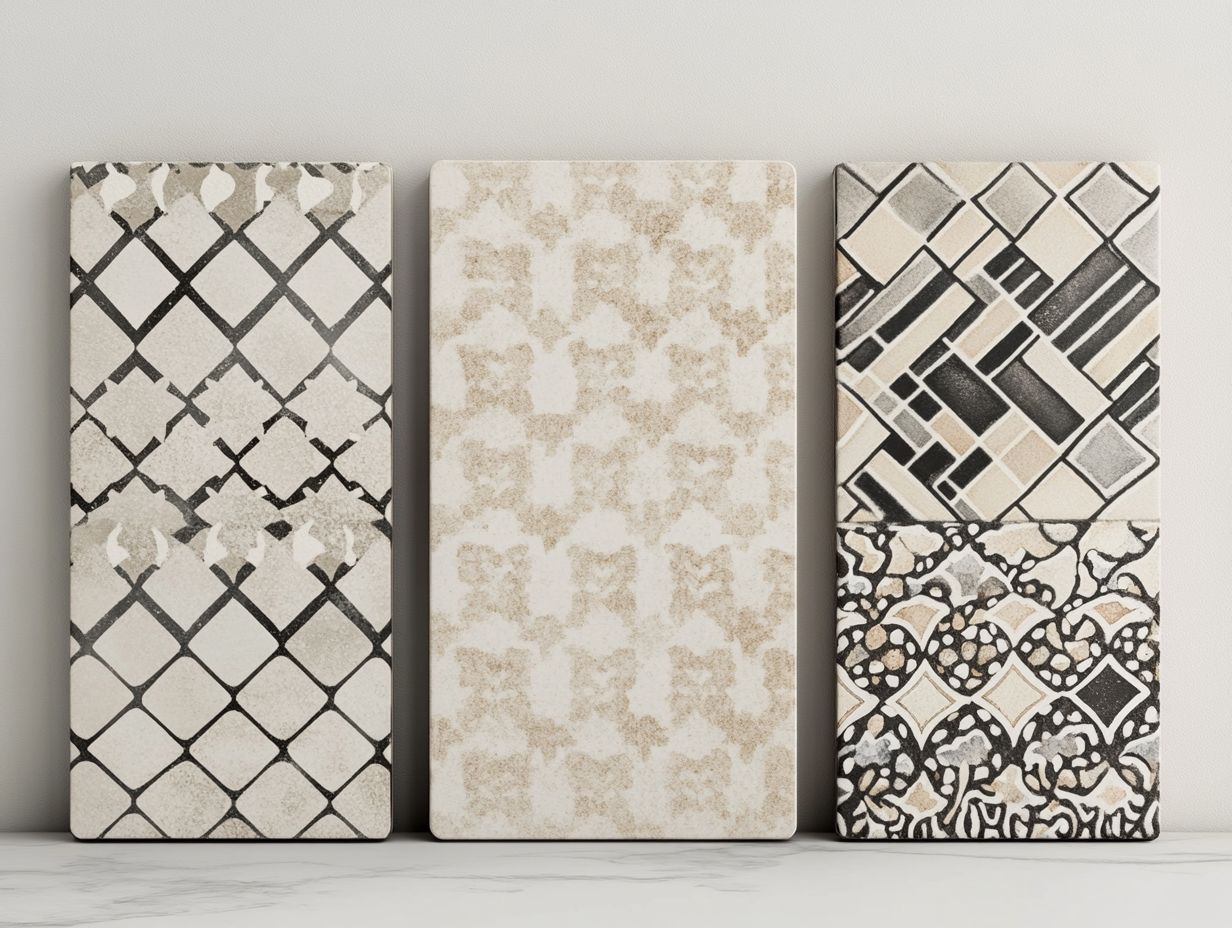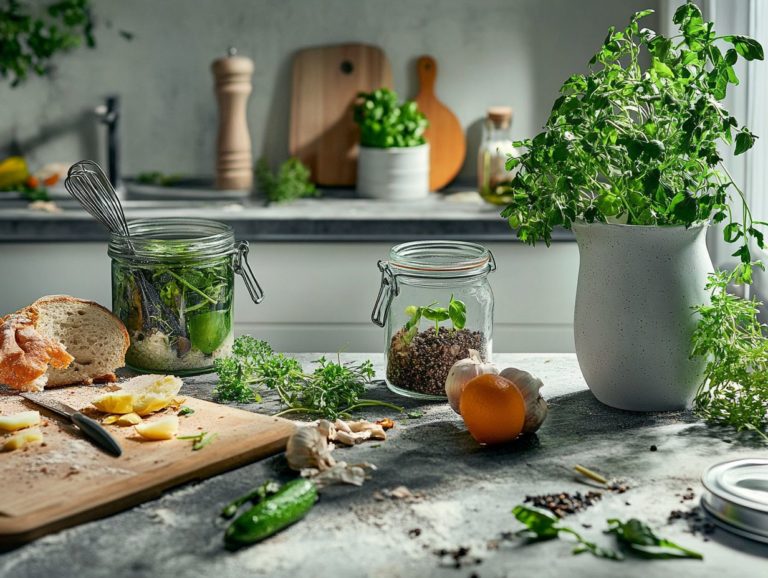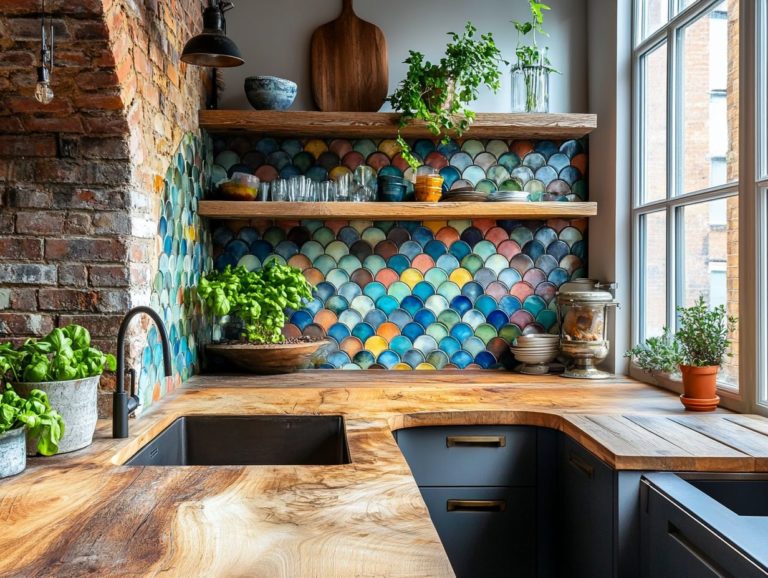5 Kitchen Tile Patterns You Need to Know
Choosing the right tile pattern can significantly enhance your kitchen’s look and function.
From the elegance of herringbone to the lively checkerboard, each pattern adds unique charm to your space.
This guide explores five essential tile patterns. You’ll find their pros and cons, how they can transform your environment, and tips for mixing and matching.
Get ready to elevate your kitchen design with the perfect tiles!
Contents
- Key Takeaways:
- 1. Herringbone Pattern
- 2. Basketweave Pattern
- 3. Subway Tile Pattern
- 4. Checkerboard Pattern
- 5. Diagonal Tile Pattern
- Which Tile Pattern Is Right for Your Kitchen?
- What Are the Key Factors to Consider When Choosing a Tile Pattern?
- How Can Different Tile Patterns Affect the Look and Feel of a Kitchen?
- What Are the Pros and Cons of Each Tile Pattern?
- How Can You Incorporate Multiple Tile Patterns in Your Kitchen?
- What Are Some Creative Ways to Use Tile Patterns in a Kitchen?
- Frequently Asked Questions
- What are the five kitchen tile patterns you need to know?
- What is the difference between herringbone and subway tile patterns?
- Can I mix and match different tile patterns in my kitchen?
- Are all five kitchen tile patterns suitable for both floors and walls?
- Which kitchen tile pattern is best for a small space?
- What color options are available for these kitchen tile patterns?
Key Takeaways:

Herringbone, basketweave, subway, checkerboard, and diagonal are five essential tile patterns for a stylish kitchen.
Consider your kitchen’s size, style, and personal preference when selecting a tile pattern.
Tile patterns can add visual interest and texture, but they may also make a space feel busy.
1. Herringbone Pattern
The herringbone pattern captivates with its zigzag design. It harmonizes beautifully with modern, traditional, and farmhouse styles.
This classic arrangement is often made with subway tiles, adding depth and personality to any space.
Its versatility shines in kitchens and bathrooms alike. Designers use it to create a cohesive look throughout the home.
Ann Wilson highlights the importance of seamless integration, while Jessica Bennett suggests using contrasting grout for added flair.
Michael Partenio notes that herringbone isn’t just pretty; it adds texture, making your rooms feel dynamic and inviting.
Use this timeless pattern to create stunning focal points in your kitchen and bathroom.
2. Basketweave Pattern
The basketweave pattern offers a classic look that enhances your kitchen and bathroom walls.
Its intricate layout is visually captivating and complements many decorating styles.
Designers recommend this pattern for flooring as it creates a solid foundation and pairs well with others like herringbone.
Experts like Christina Wedge and Edmund Barr emphasize its adaptability, making it ideal for creating timeless designs.
3. Subway Tile Pattern
The subway tile pattern is a staple in minimalist and traditional kitchens. It features clean lines that enhance your space.
A contrasting grout color can add depth and elevate the overall appearance.
Originating from early 20th-century New York, this classic design has become popular in contemporary decor.
Subway tiles come in many colors and textures, allowing for unique combinations that fit various styles.
Choosing the right adhesive and ensuring proper alignment are key to a successful installation.
The creative possibilities are endless—stack your tiles vertically for a bold look, or try herringbone for added character.
4. Checkerboard Pattern

The checkerboard pattern is a dynamic design choice that infuses energy and vibrancy into your kitchen. It offers an eye-catching texture that can elevate ordinary spaces into extraordinary focal points.
This versatile pattern can be creatively employed in both kitchens and bathrooms. It seamlessly adapts to various styles, whether you prefer modern minimalism or rustic charm.
Experts, including Marty Baldwin, highlight how this style enhances visual interest in high-traffic areas.
Imagine creating striking contrasts with black and white tiles in your contemporary kitchen. Softer pastel colors can be used in your bathroom for a more soothing ambiance.
Adam Albright points out that the playful arrangement of checkerboard tiles disrupts monotony. This results in unique design narratives tailored specifically to your taste.
5. Diagonal Tile Pattern
The diagonal tile pattern presents an exhilarating twist on traditional layouts. It creates a distinct visual flow in your flooring ideas and home design.
This approach breaks free from the conventional and enhances the perception of space. It can make smaller kitchens and bathrooms feel larger and more inviting.
Designers like Emily Followill note that laying tiles diagonally can create a feeling of space. This pattern skillfully diverts attention from angular corners, softening the overall look while injecting artistic flair.
It is a compelling way to rejuvenate a space, offering visual allure and practical benefits.
Which Tile Pattern Is Right for Your Kitchen?
Choosing the right tile pattern for your kitchen requires thoughtful consideration of various factors. These include your style, kitchen design, and how the flooring contributes to the overall look.
When selecting tile patterns, assess the size of the room. Larger spaces often benefit from bold designs that create visual interest. In contrast, smaller areas thrive with simpler, more subdued patterns.
Your personal style is essential here. Modern aesthetics lean toward geometric designs, while traditional approaches embrace intricate patterns that evoke nostalgia. If you like farmhouse styles, rustic tiles with weathered finishes add warmth and charm.
Aligning your tile choice with these considerations can elevate the ambiance of your kitchen. Transform it into a welcoming space for family and friends.
What Are the Key Factors to Consider When Choosing a Tile Pattern?
When selecting a tile pattern, several key factors deserve attention. These include the design of your kitchen, the overall style of your home, and the decorating styles that resonate with your taste.
The size of your kitchen significantly influences your tile choices. In a spacious kitchen, you have the freedom to experiment with bold designs or intricate patterns. Conversely, in a smaller kitchen, lighter, more uniform tiles create an illusion of openness.
Light exposure is another critical element. A sunlit kitchen benefits from reflective tiles that enhance brightness. A dimly lit area may call for warmer tones that foster a cozy atmosphere.
Lastly, don’t overlook existing color schemes. Your chosen tiles should harmonize with these colors for a cohesive look. Aim to blend different patterns seamlessly without overwhelming the space.
Explore your design choices now and make your kitchen truly yours!
How Can Different Tile Patterns Affect the Look and Feel of a Kitchen?

Different tile patterns can dramatically influence the ambiance of your kitchen. They can set the tone from sleek modern styles to warm, inviting traditional looks, ultimately shaping your culinary experience.
For instance, when you incorporate a zigzag pattern, you’re bringing a touch of elegance and sophistication into the space. This design gracefully draws the eye through the room, adding visual depth without overwhelming the overall look.
On the flip side, diagonal tile patterns can make a small kitchen feel more expansive. They draw the gaze outward and, when combined thoughtfully, enhance the room’s functionality while creating distinct zones.
The right tile choices reflect your personal taste and elevate the entire design, making your kitchen a true expression of who you are.
What Are the Pros and Cons of Each Tile Pattern?
Each tile pattern presents a unique set of advantages and disadvantages, shaping its appropriateness for kitchen design and bathroom renovations. Understanding these nuances gives you the power to make informed choices for your home.
Take subway tiles, for example. Their classic rectangular shape exudes timeless charm and versatility. However, be prepared for frequent cleaning due to the visibility of grout.
Then there are herringbone patterns, which are visually captivating and inject dynamic energy into a space. However, their intricate installation can lead to elevated labor costs—something to keep in mind.
Checkerboard tiles offer a bold style that can enhance your floor’s appeal. Yet, they tend to reveal dirt and wear more readily, demanding regular upkeep.
Each pattern carries distinct practical implications, giving you the opportunity to customize your spaces to reflect your unique needs and style.
How Can You Incorporate Multiple Tile Patterns in Your Kitchen?
You can creatively blend multiple tile patterns in your kitchen to elevate the space into something visually striking. This approach adds depth while reflecting your unique decorating preferences.
By utilizing a cohesive color palette with various tile shapes, such as geometric and subway tiles, you can unify your look while offering contrast.
Implementing spacing strategies, like staggered layouts or linear arrangements, elongates the visual perception of the room. Professionals like Michael Partenio often employ these techniques, seamlessly blending vibrant blue mosaics with subtle white ceramic tiles.
This harmonious combination creates an inviting atmosphere that balances modernity with traditional charm, making your kitchen a true masterpiece.
What Are Some Creative Ways to Use Tile Patterns in a Kitchen?
Creative uses of tile patterns can elevate your kitchen’s style and functionality, transforming ordinary spaces into extraordinary culinary havens brimming with personality.
By incorporating unique and striking tile designs in various applications, you can achieve a personalized aesthetic. Designers like Ann Wilson emphasize that using tiles for accent walls creates a dramatic backdrop, while subtle backsplash choices enhance the overall kitchen ambiance.
Jessica Bennett encourages you to experiment with mixed flooring ideas, merging different tile shapes and colors to add depth and interest. These innovative approaches showcase your individual tastes while maintaining artistic flair.
Frequently Asked Questions

This section addresses common inquiries related to tile patterns in kitchen design. Explore answers to help you make informed choices for your space.
What are the five kitchen tile patterns you need to know?
Discover the five kitchen tile patterns: herringbone, subway, basketweave, hexagon, and arabesque. These styles will elevate your kitchen’s look and add visual flair.
What is the difference between herringbone and subway tile patterns?
Herringbone arranges rectangular tiles in a zigzag pattern. Subway lays them in a straight line, offering a classic, timeless appeal.
Can I mix and match different tile patterns in my kitchen?
Absolutely! Mixing tile patterns can create a unique, personalized look. Just choose designs that complement each other.
Are all five kitchen tile patterns suitable for both floors and walls?
Most of these five patterns, like herringbone, subway, and hexagon, work well on both floors and walls. However, basketweave and arabesque are typically better suited for walls or backsplashes.
Which kitchen tile pattern is best for a small space?
Herringbone and subway patterns are perfect for small spaces as they create an illusion of more area. To add texture, consider a basketweave or hexagon design.
What color options are available for these kitchen tile patterns?
The color choices are endless! From classic neutrals like white and gray to bold options like blue or green, pick what suits your style and kitchen vibe.





